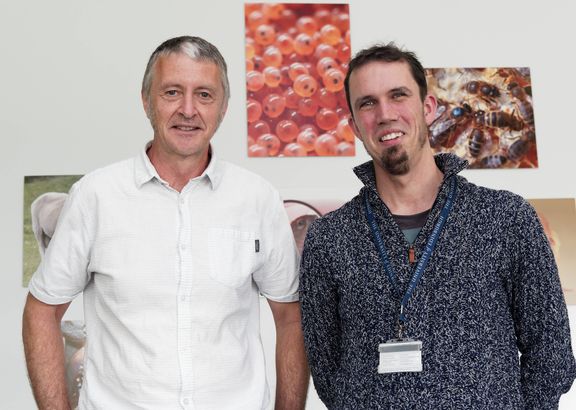
News & Views
Fish Health
Research
Nofima investigates genetic factors influencing salmon’s resistance to sea lice
December 21, 2023 By Hatchery International staff
 Nick Robinson and Diego Robledo, together with partners from Nofima, Deakin University and the University of Edinburgh, have produced a useful guide to the use of gene editing. Photo: Georg Mathisen / Nofima
Nick Robinson and Diego Robledo, together with partners from Nofima, Deakin University and the University of Edinburgh, have produced a useful guide to the use of gene editing. Photo: Georg Mathisen / Nofima Scientists at Nofima are studying the genetic mechanisms that affect salmon’s resistance to lice.
The scientists will test which genes can affect whether salmon can repel lice infestation and look at what happens exactly where the lice attach themselves to the salmon and the importance of genes in stopping the lice.
Sea lice live by eating skin and blood. Salmon become sick and lice are a problem both for fish welfare and for the industry. But there are salmon that do well against salmon lice.
“In wild coho salmon, this occurs naturally. The cells of the salmon surround the lice and kill them,” said Diego Robledo, one of the scientists on the project.
Coho and pink are two salmon species native to the Pacific Ocean that combat sea lice naturally in a way that Atlantic salmon cannot manage.
Nick Robinson is a senior scientist at Nofima in Norway and also working on the project.
“Our genomic research is helping us to understand which genes are involved in providing resistance against sea lice in the Pacific salmon species, and the next step in our project is to test the function of these genes in Atlantic salmon using gene editing. Early next year, we will be ready to introduce gene-edited Atlantic salmon to sea lice in a closed biosecure facility. We want to see whether small and precise changes disrupting the function of these genes can cause the immune cells in Atlantic salmon to encapsulate the lice and kill them like occurs in coho, or to prevent attachment like occurs in pink salmon,” said Robinson.
Salmon lice tend to settle on Atlantic salmon than on other salmon species, and if scientists find out why, it can help salmon avoid lice altogether.
“The benefits could be large in the future if it is possible to use the knowledge gained from the project to produce a resistant salmon. Lice create wounds that become infected. If we can help the fish to become resistant to lice, it has benefits for fish welfare. By potentially changing the whole epidemiology of lice infection on farms we could also relieve the lice pressure on wild salmon”, Robinson said.
The scientists will edit genes that their research suggests will keep salmon healthy and the lice away but they need to be sure that gene editing is safe to use on salmon that are to be farmed and sold.
”In each instance, there needs to be a thorough evaluation of how the edit might affect the welfare and health of the fish, the aquatic ecosystem and society. This should involve consumers and other interest groups in the decision-making process. The benefits should be weighed in relation to any potential harms”, said Robinson and Robledo.
They have written a guide along with other collaborators from Nofima, the University of Edinburgh and Deakin University in Australia that helps assess the risks of gene editing.
“The guide was written to help assess risks and benefits so that informed decisions can be made,” said Robledo.
“The changes we are making are quite small. We don’t take genes from other animals, we make slight adjustments to the genes that salmon already have,” added Robinson.
Print this page





